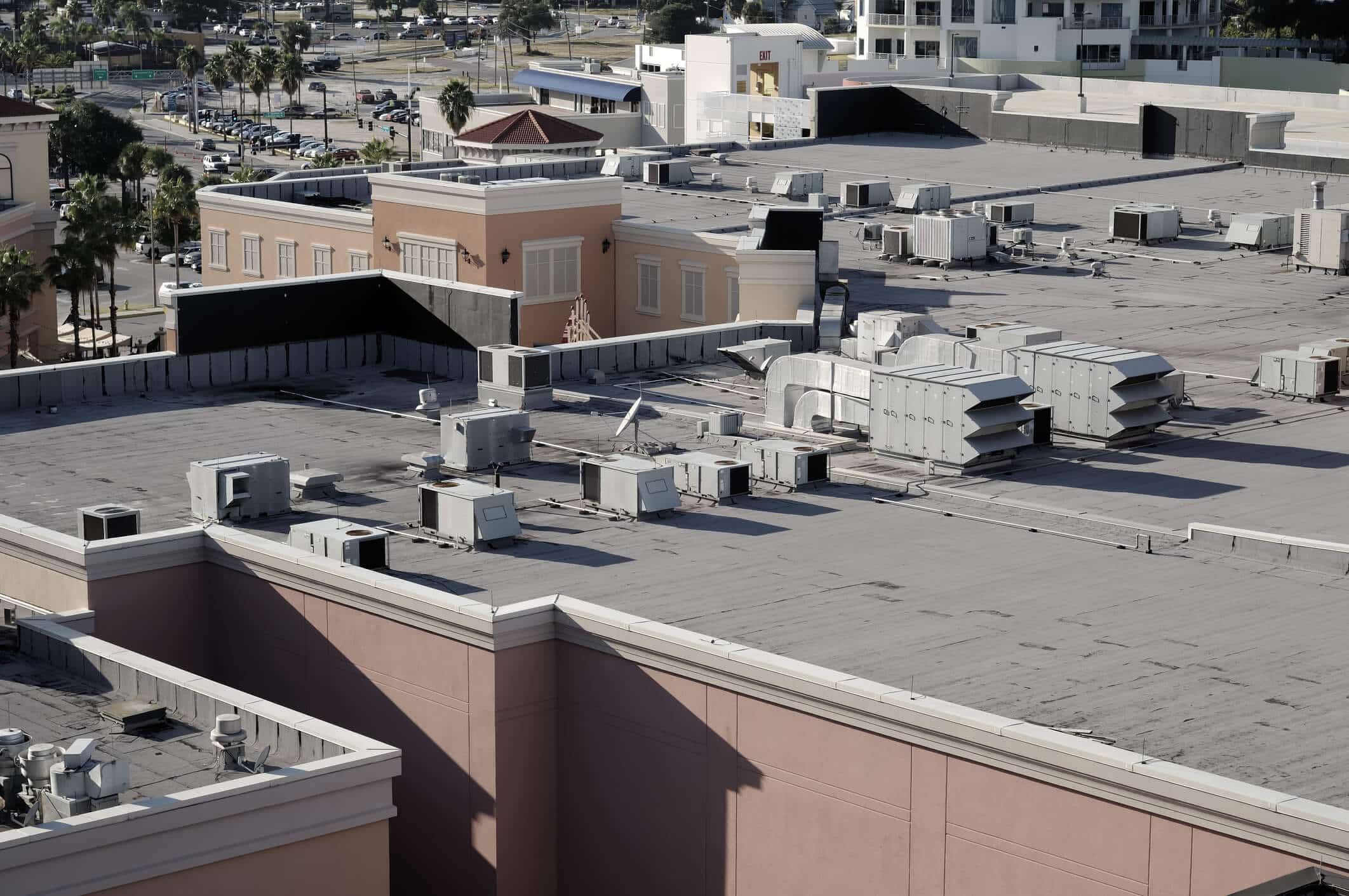
It usually starts with a small drip. Then a water stain. Maybe a musty smell you can’t quite place. If you’re a homeowner or property manager with a flat roof, you already know—when something goes wrong, it’s rarely simple.
Flat roofs are notorious for hiding damage until it’s too late. And when you finally call for help, you’re met with conflicting advice: “Just patch it.” “You need a full replacement.” “That’ll be $10,000.” Sound familiar?
At Mr. Roofer, we understand the stress, confusion, and financial anxiety that come with flat roof problems. That’s why we do things differently. With decades of hands-on experience and a repair-first mindset, we specialize in diagnosing issues others miss and fixing them the right way, the first time.
In this guide, we’ll discuss the most common flat roof issues, materials, inspection methods, and how to determine whether repair or replacement is truly necessary. Most importantly, we’ll show you how to find flat roof repair companies that value honesty as much as craftsmanship.
Because peace of mind shouldn’t be a luxury, it should be part of the job.
Flat Roof Repair Near Me: Common Issues That Require Flat Roof Repairs
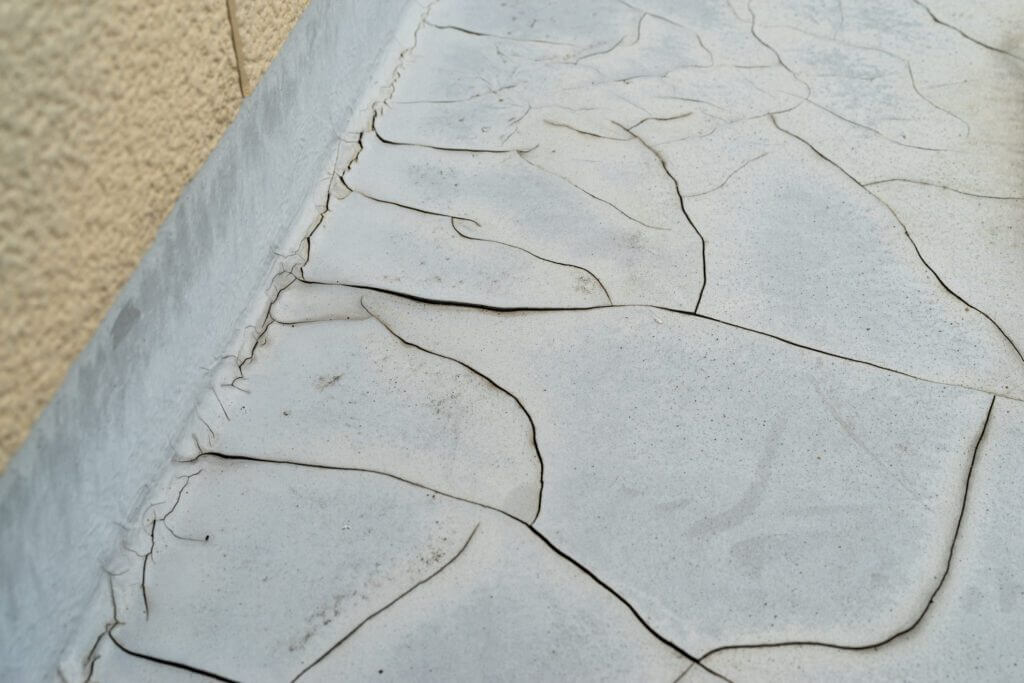
Flat roofs are popular for their modern aesthetic and space efficiency, but they also present unique maintenance challenges. Unlike sloped roofs, flat roofs are more prone to water retention, structural stress, and weathering—all of which can lead to costly damage if not addressed early. Below are some of the most common issues that signal the need for professional flat roof repair near me:
Ponding Water
Ponding water refers to water that remains pooled on a flat roof for more than 48 hours after rain. This issue often results from inadequate drainage systems, sagging roof decks, or design flaws. Over time, stagnant water can degrade roofing materials, increase the load on the structure, and become a breeding ground for algae and mold. Left unaddressed, it compromises the roof’s integrity and shortens its lifespan.
Blistering or Bubbling
Blistering or bubbling occurs when air or moisture becomes trapped between layers of roofing materials, typically in built-up roofs or membrane systems like EPDM, TPO, or modified bitumen. These raised areas weaken the membrane and can eventually rupture, allowing water to infiltrate the structure below.
Membrane Cracks or Punctures
Flat roof membranes are engineered to be durable, but they’re not immune to damage. Foot traffic, fallen branches, HVAC servicing, and extreme weather events can lead to cracks or punctures in the surface.
These seemingly minor issues can allow moisture to seep in, leading to:
- Interior water damage
- Insulation degradation
- Mold growth
Seam Delamination
In single-ply membrane systems like TPO or PVC, seams are typically heat-welded or chemically bonded. When these seams begin to separate or delaminate, water can infiltrate beneath the membrane and cause widespread damage. Seam failure is often due to improper welding during installation, natural expansion and contraction, or UV degradation.
Poor Previous Installation
Many flat roof issues can be traced back to substandard workmanship during initial installation. Improper membrane alignment, inadequate flashing, poor adhesion, or incorrect slope design can lead to persistent and compounding problems over time.
Flat Roof Repair Near Me: Flat Roof Materials and How They Affect Repairs
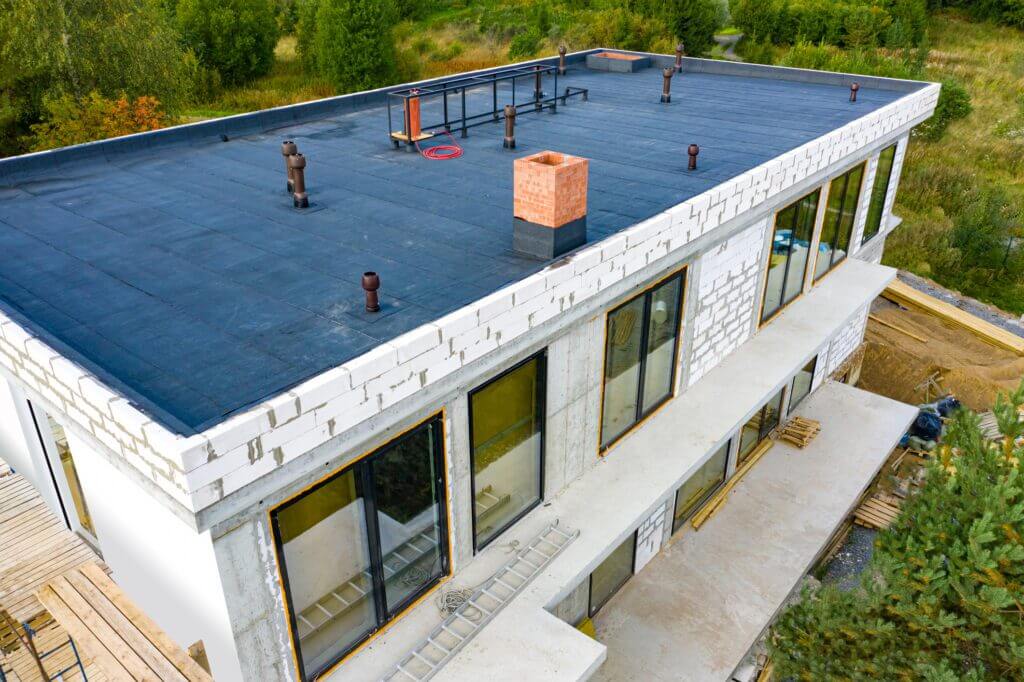
Each roofing system has its own set of characteristics, benefits, and vulnerabilities—knowing the difference is key to making informed decisions about maintenance and restoration.
Below is an overview of the most common flat roof materials and how they affect repair strategies.
Modified Bitumen
Modified bitumen is an asphalt-based roofing system reinforced with polymers for added strength and flexibility. It’s typically installed in rolls and applied using heat (torch-down), cold adhesives, or peel-and-stick methods.
Repair considerations:
Modified bitumen is relatively straightforward to patch, especially when damage is isolated. Blisters, cracks, and punctures can be addressed using torch-welded patches or cold-process materials. However, repairs must be handled by trained professionals due to the fire risks associated with torch-down methods.
EPDM (Rubber)
EPDM (ethylene propylene diene monomer) is a synthetic rubber membrane known for its excellent UV resistance and flexibility in extreme temperatures. It’s typically black, single-ply, and adhered using mechanical fasteners or glue.
Repair considerations:
EPDM can develop shrinkage, seam failures, or punctures from debris and foot traffic. Repairs involve specialized adhesives and membrane-compatible patches. Unlike other systems, EPDM cannot be heat-welded, requiring chemical bonding for effective sealing.
TPO (Thermoplastic Polyolefin)
TPO is a white, reflective, single-ply membrane that has gained popularity for its energy efficiency and heat-weldable seams. It’s commonly used in both residential and commercial flat roofs.
Repair considerations:
TPO repairs require professional heat welding equipment and precise temperature control. Seam failures, punctures, or membrane degradation from UV exposure are common issues. Improper or DIY repairs can cause more harm than good, making experienced flat roof repair companies like Mr. Roofer essential for TPO systems.
Built-Up Roofing (BUR)
Built-up roofing consists of multiple layers of asphalt and reinforcing fabrics, often topped with gravel or a reflective coating. It’s one of the oldest flat roofing systems and is valued for its thickness and durability.
Repair considerations:
Due to its layered construction, BUR is labor-intensive to repair. Blisters, cracks, and splits must be carefully cut out and patched with compatible materials. Leaks can be difficult to locate, requiring experienced eyes and infrared diagnostics.
How the Material Affects Durability, Cost, and Repair Method
Each flat roof material has a unique impact on the overall maintenance lifecycle:
- Durability: Systems like EPDM and BUR are known for long-term performance, while TPO offers good durability with energy efficiency benefits. Modified bitumen falls in the middle, offering reliable protection if properly maintained.
- Cost: EPDM and TPO are generally more affordable to install and repair. BUR and modified bitumen can be more costly due to labor demands and material complexity.
- Repair Method: The repair process varies significantly. TPO and modified bitumen require heat-based methods, while EPDM relies on adhesives. BUR demands more invasive work due to its built-up layers.
Flat Roof Repair or Full Replacement: How to Decide
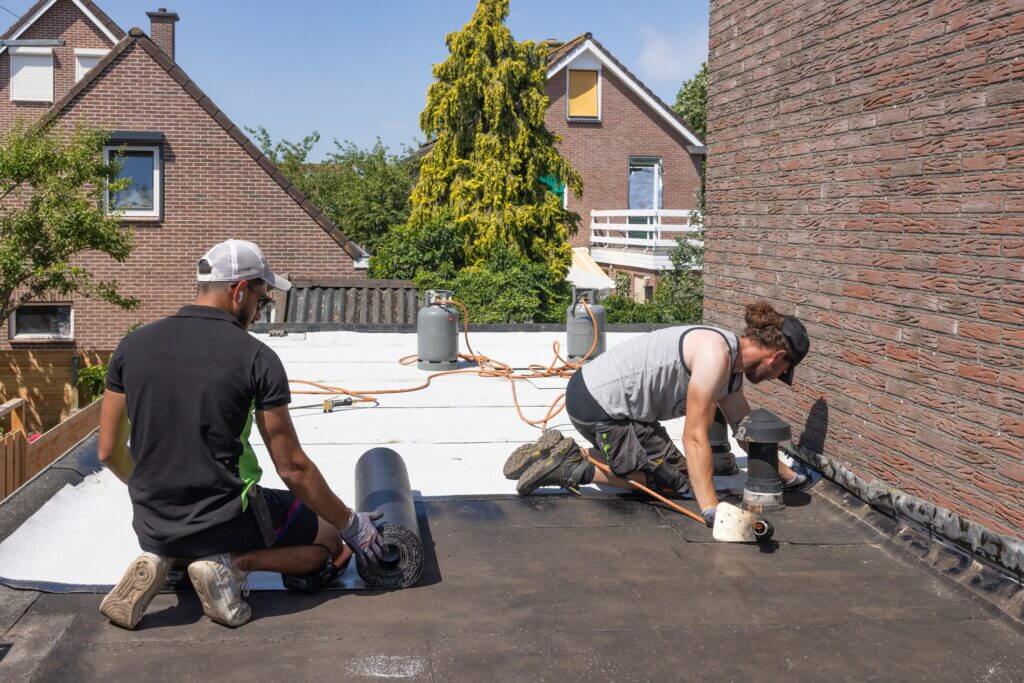
One of the biggest challenges flat roof owners face is determining whether to continue with repairs or invest in a full replacement. While ongoing repairs can be cost-effective in the short term, there comes a point when patchwork becomes inefficient or even risky. Evaluating the long-term health of your flat roof requires a balanced assessment of several key factors.
Here’s a quick table to help you evaluate what’s right for you:
Factor | Repair | Full Replacement |
Roof Age | Under 15 years, generally in good condition | Over 15-20 years, nearing the end of life |
Issue Severity | Isolated leaks, small punctures, flashing damage | Widespread damage, systemic failure, recurring leaks |
Water Damage | Localized, surface-level moisture issues | Deep saturation, compromised insulation, or decking |
Repair History | Few past repairs, no recurring issues | Frequent patches with diminishing results |
Cost Considerations | Lower upfront cost, good for short-to-mid term | Higher upfront cost, but better long-term value |
Downtime/Disruption | Minimal – quicker to complete | Longer project timeline, more disruption |
Long-Term Value | Great for newer roofs with isolated issues | Ideal for aging roofs needing a total performance reset |
Mr. Roofer’s Recommendation | When issues are fixable and the structure is sound | When repairs are no longer cost-effective or reliable |
Let’s take a deep dive to help you make the right decision for your roof, budget, and peace of mind.
Age of the Current Roof System
Most flat roof systems have an expected service life of 10 to 30 years, depending on the material and maintenance. TPO and modified bitumen often range from 15 to 20 years, while EPDM and BUR systems, when well maintained, can extend past 30 years.
Extent of Water Damage
Water damage is one of the most telling indicators of a roof’s health. Isolated leaks with clear entry points can usually be repaired with minimal disruption. However, widespread saturation, mold infiltration, or damage to insulation layers beneath the membrane may signal systemic failure.
Frequency of Past Repairs
A history of frequent repairs can point to underlying problems with the roofing system that aren’t being fully addressed, whether due to:
- Poor installation
- Material fatigue
- Improper maintenance
When the cost of constant patching begins to rival that of a new roof, it’s time to re-evaluate.
Underlying Structural Issues
Roofing issues don’t always originate with the membrane. Structural concerns such as sagging decks, deteriorating support beams, or inadequate slope design can make repair efforts ineffective. In such cases, even the best repair work won’t hold if the structure beneath is failing.
How Mr. Roofer Helps Customers Evaluate With Honesty, Not Pressure
What sets Mr. Roofer apart is our repair-first mindset and customer-focused approach. We understand that a roof replacement is a major decision, not just a construction project, but a financial and emotional investment. That’s why we provide transparent, objective recommendations backed by decades of experience, not sales tactics.
Our process includes:
- Comprehensive photo documentation
- Clear explanation of all findings and options
- Side-by-side cost comparisons
- Timelines for repair vs. replacement outcomes
- No-obligation quotes and pressure-free consultations
Flat Roof Repair Near Me: What to Expect from a Flat Roof Inspection
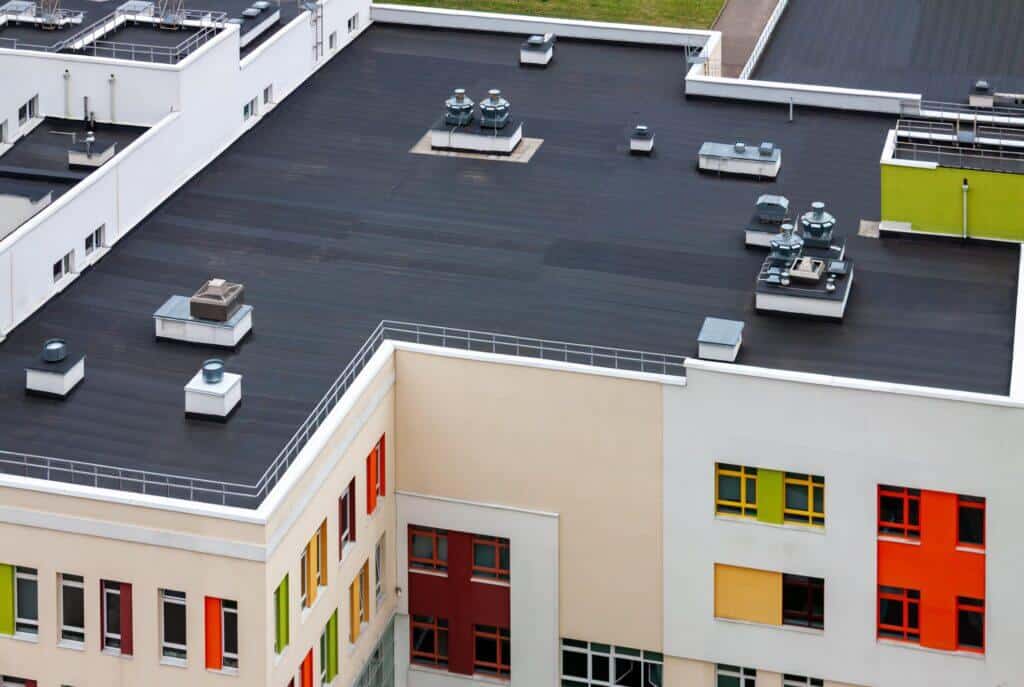
A thorough flat roof inspection is the foundation of any effective repair or replacement strategy. Because flat roofs can conceal damage beneath the surface, or exhibit symptoms far from the actual source of the issue, it takes specialized tools and experience to uncover the real problems.. Here’s what you can expect during a professional flat roof inspection with our team.
Moisture Scanning and Surface Assessment
Surface-level signs of wear—like bubbling, discoloration, and soft spots—often point to deeper issues, especially when water has infiltrated insulation layers or the decking below. Mr. Roofer utilizes advanced moisture detection tools, including infrared scanners and moisture meters, to detect hidden saturation that the naked eye can miss.
Flashing, Vent, and Membrane Inspection
Penetrations like vents, drains, HVAC curbs, and skylights are common entry points for water and frequent failure zones. Flashing that has pulled away, cracked, or has been poorly installed can compromise the waterproofing system.
Mr. Roofer pays special attention to:
- Perimeter flashing at parapet walls or edges
- Sealants around mechanical penetrations
- Welded seams or adhesive bonds in membrane systems
Interior Water Damage Review
Flat roof problems often reveal themselves indoors long before they’re visible from the outside. A proper inspection includes reviewing ceilings, walls, and attic spaces for:
- Staining
- Mold growth
- Compromised insulation
By correlating interior signs of damage with exterior inspection results, Mr. Roofer ensures a more accurate diagnosis. This step is critical in determining how far water has traveled and what repairs are needed to fully resolve the issue, not just patch the symptom.
Why Photo Documentation Is Key to Understanding the Problem
Clear photo documentation is a cornerstone of Mr. Roofer’s process. During the inspection, we capture high-resolution images of all identified issues, including ponding areas, seam failures, damaged flashing, interior staining, and more.
These photos are:
- Included in your inspection report
- Paired with plain-language explanations
- Used to compare before-and-after conditions if repairs are performed
Mr. Roofer’s Promise: Clear Diagnosis and No-Push Solutions
At Mr. Roofer, we believe in educating our clients, not selling to them. Our inspection process is designed to arm you with facts, options, and clarity, not scare tactics or rushed decisions.
What you can count on:
- A detailed inspection report with photos and expert recommendations
- Honest, unbiased guidance—whether the solution is a $300 repair or a full replacement
- Zero pressure to commit on the spot
- Answers to all your questions, with a focus on long-term value
Flat roofs may be complex, but finding the right path forward doesn’t have to be. With Mr. Roofer, you can expect a thorough inspection process that’s built on integrity, not upselling.
Flat Roof Repair Near Me: How to Find the Best Flat Roof Contractors Near You
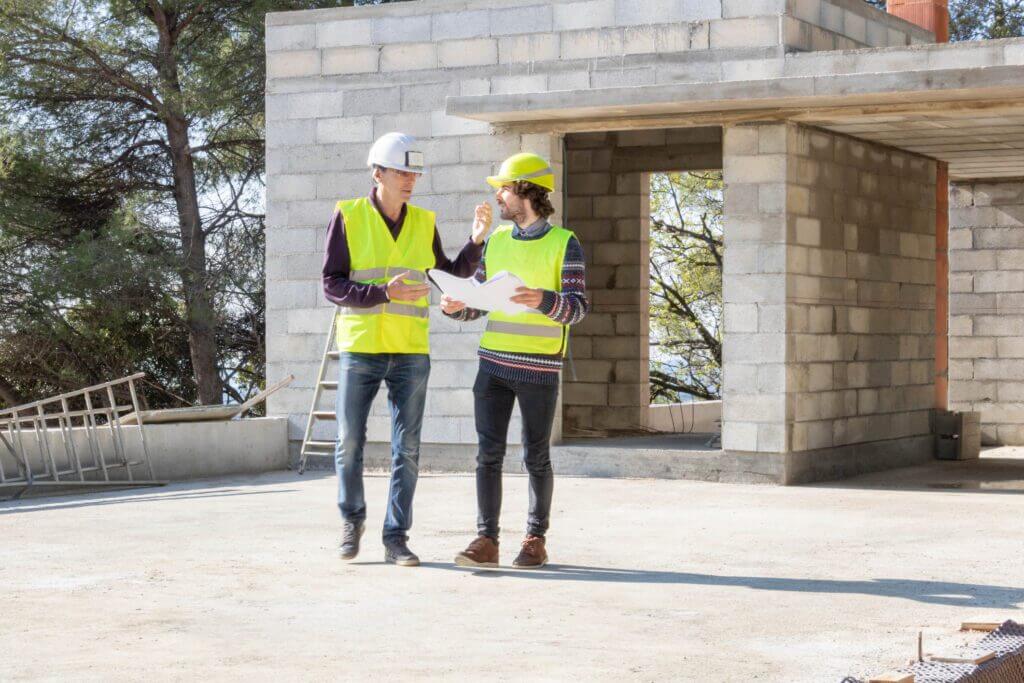
Flat roof repair and replacement isn’t a one-size-fits-all job. Because flat roofing systems require specialized expertise, hiring the right contractor is essential to getting durable, cost-effective results. Unfortunately, many general roofers or even flat roof specialists near me fall short when it comes to accurate diagnosis, material knowledge, or honest recommendations.
If you’re searching for a flat roof specialist near you, here’s how to vet the professionals and avoid costly mistakes.
What to Look For
Local Reputation
Start by looking for flat roof repair companies with a strong local presence and proven track record. Check for Google reviews, Better Business Bureau ratings, and customer testimonials that specifically mention flat roof repairs, not just sloped residential shingle work. A well-reviewed flat roof repair company that’s trusted in your community is more likely to stand behind their work.
Photo Examples of Past Flat Roof Jobs
Ask to see documentation of completed flat roof repairs and replacements. Reputable flat roof contractors like Mr. Roofer keep a portfolio of before-and-after photos, showcasing the complexity and quality of their work. Bonus points if they can share case studies or explain the materials and methods used.
Knowledge of Multiple Flat Roof Materials
Every flat roofing material behaves differently. Contractors should demonstrate familiarity with systems like EPDM, TPO, modified bitumen, and BUR. They should also explain the pros and cons of each and how they tailor repairs or replacements based on material compatibility, building type, and climate.
Proper Licensing and Insurance
Any flat roof repair company working on your property should carry up-to-date general liability insurance, workers’ compensation coverage, and state or local licensing. This protects you from liability and ensures the contractor meets regulatory and safety standards. Don’t settle for verbal confirmation—ask for documentation.
Red Flags
Vague or Verbal-Only Estimates
If a contractor can’t provide a detailed written estimate that outlines labor, materials, and scope of work, that’s a major red flag. Ambiguous pricing can lead to surprise costs later. At Mr. Roofer, all estimates are itemized, transparent, and backed by a thorough inspection.
No On-Site Inspection Before Quoting
Be wary of anyone who offers pricing over the phone or provides a quote without physically examining the roof. Flat roof problems are often hidden and can’t be accurately diagnosed without a close-up inspection and moisture testing. Skipping this step is both careless and unprofessional.
Pushes for Full Replacement Without Justification
Some contractors default to full replacement because it’s more profitable, even when a targeted repair would suffice. If you’re being pressured to replace your entire roof without documented proof of failure or a side-by-side cost-benefit analysis, walk away.
Ready to Solve Your Flat Roof Problems? Trust Mr. Roofer to Get It Right
Flat roof repairs require precision, experience, and a commitment to doing what’s right for the customer. Whether you’re dealing with ponding water, blistering membranes, or years of patchwork repairs, one thing is clear: a quick fix won’t do. You need real answers, reliable solutions, and a team that knows the difference between a problem and a symptom.
At Mr. Roofer, we specialize in diagnosing and repairing flat roofs with integrity and expertise. Our repair-first mindset means we explore every viable fix before recommending full replacement. And when replacement is necessary, we guide you through it with transparency and care—no pressure, no guesswork.
Whether you’re a homeowner, property manager, or business owner, we’re here to help you make smart, confident decisions about your roof.
Contact us today to get started. Because with Mr. Roofer, you’re not just getting a contractor—you’re gaining a trusted partner in roof repair.
